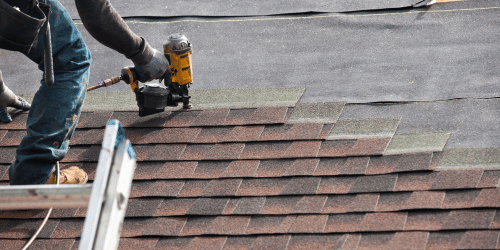When Should You Replace Your Roof in Texas
Your roof is your home’s first line of defense against the unpredictable Texas weather. From scorching summer heat to occasional storms, your roof takes the brunt of it all. Ensuring the longevity and safety of your roof is paramount. In this comprehensive guide, we’ll delve deep into the crucial factors that determine when it’s time for a roof replacement in Texas. By the end of this article, you’ll be equipped with the knowledge needed to make informed decisions about the protection and maintenance of your home.
Key Takeaway:
The key to knowing when to replace your roof in Texas is to pay attention to the signs of wear and damage, conduct regular inspections, and seek professional guidance to determine the optimal timing for replacement.
Section 1: Recognizing the Signs of a Texas-Worn Roof
The diverse and often harsh climate of Texas can take a toll on your roof over time. Recognizing the early signs of wear is crucial to preventing more extensive damage. Look out for these indicators that your roof may need replacement:
Sun-Damaged Shingles:
The relentless Texas sun can cause shingles to deteriorate gradually. Over time, this can lead to cracks, warping, and fading. Regularly inspect your shingles for signs of sun damage, such as brittleness or discoloration. If you notice these signs, it’s a clear indication that your shingles might need replacement.
Impact of Extreme Weather:
Texas is no stranger to extreme weather events, including hailstorms and high winds. These natural occurrences can wreak havoc on your roof, leading to missing shingles, dents, and even leaks. After a storm, it’s imperative to conduct a thorough inspection to identify any storm-related damage promptly.
Moss and Algae Growth:
The humid climate in certain parts of Texas creates a favorable environment for the growth of moss, algae, and mold on your roof. These growths not only compromise your roof’s integrity but also contribute to water damage and leaks. Regularly inspect your roof for any signs of these growths, and take prompt action to mitigate their impact.
Section 2: Types of Roofing Materials for Texas
The choice of roofing material plays a pivotal role in determining how well your roof withstands the challenges posed by the Texas climate. Consider these options:
- Metal Roofs: Metal roofs have gained popularity in Texas due to their exceptional durability. They are engineered to withstand the harshest weather conditions, including intense sunlight, hail, and high winds. Metal roofs also offer the advantage of reflecting sunlight, which helps reduce heat absorption and keeps your home cooler during scorching Texas summers.
- Asphalt Shingles: Asphalt shingles remain a popular choice for their affordability and versatility. However, not all asphalt shingles are created equal. Opt for high-quality shingles with robust UV resistance to extend their lifespan in the Texas climate.
- Flat Roofs: Flat roofs are commonly found in both commercial and residential properties in Texas. Proper installation and ongoing maintenance are essential for preventing water pooling, which can lead to leaks and premature deterioration. Regular inspections and proactive upkeep are crucial to ensure the longevity of flat roofs.
Section 3: Extending Roof Lifespan in Texas
Given the unique challenges posed by Texas weather, taking proactive measures to extend your roof’s lifespan is paramount:
Regular Inspections:
Schedule annual roof inspections by professionals who are well-versed in the intricacies of Texas roofs. Timely detection of potential issues allows for swift intervention, preventing minor problems from escalating into major concerns.
Maintenance and Cleaning:
Regular maintenance and cleaning are crucial to the health of your roof. After severe weather events, promptly remove debris and address any visible damage. Additionally, keep an eye out for moss and algae growth, particularly in areas with high humidity.
Proper Ventilation:
Adequate attic ventilation is a critical factor in maintaining a healthy roof in Texas. Proper ventilation helps regulate temperature and moisture levels, preventing excess heat buildup and moisture-related damage. It also contributes to improved energy efficiency, reducing cooling costs during the hot Texas summers.
Answering Common Questions:
- Question: When Should I Consider Roof Replacement in Texas? Answer: The decision to replace your roof depends on various factors, including the age of the roof, signs of damage, and the roofing material used. Regular inspections and addressing issues promptly are fundamental to determining the right time for a roof replacement.
- Question: Can I Delay Roof Replacement After Storm Damage? Answer: While immediate repairs are essential after storm damage, delaying a necessary roof replacement can lead to further deterioration and increased costs. Address storm-related damage promptly to safeguard the longevity of your roof.
- Question: Should I Get a Metal Roof in Texas? Answer: Absolutely. Metal roofing is an excellent choice for Texas due to its remarkable durability and ability to withstand the elements. Its heat-reflective properties contribute to a cooler home and lower energy costs.
The Impact of Proper Ventilation:
In the context of Texas weather, proper attic ventilation takes on added importance. Let’s explore its benefits in more detail:
Ventilation and Energy Efficiency:
In the scorching Texas heat, proper attic ventilation offers a multitude of benefits. By preventing excess heat buildup, ventilation helps regulate indoor temperatures, reducing the strain on your cooling systems. This translates to lower energy consumption and more comfortable living spaces. Moreover, improved energy efficiency has positive implications for both the environment and your monthly utility bills.
Seeking Expert Advice:
Navigating the nuances of roof replacement in Texas requires expertise tailored to the region’s unique challenges. Relying on professionals with in-depth knowledge of Texas roofing can make all the difference in ensuring the longevity and performance of your roof. Whether it’s selecting the right roofing material or addressing specific concerns, expert guidance ensures you make informed decisions.
Resources for Further Reading: For those seeking a deeper understanding of roofing materials and their impact in the Texas climate, consider exploring these resources:
Conclusion: As a proud homeowner in Texas, safeguarding the integrity of your roof is an investment in the protection and comfort of your family. By remaining vigilant, conducting regular inspections, and making well-informed decisions, you can ensure your roof stands resilient against the challenges of Texas weather for years to come. For more personalized guidance and to take the next steps in roof replacement and roof repair, visit Surface Roofing. Our team is dedicated to providing top-notch services that align with the unique requirements of Texas homes.







